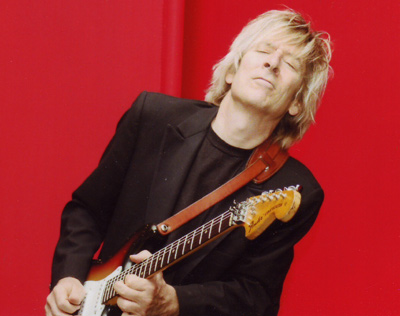

By no stretch of the imagination could Frank Zappa be considered your average, everyday guitar hero. Sure, he possessed a capacity for blinding speed and could zoom around the fretboard with abandon, but it was his unique approach to guitar solos in general that made him such an iconoclast. Brimming with sophisticated motifs and convoluted rhythms, Zappa's extended excursions are more akin to symphonies than they are to guitar solos. In retrospect, it was only Frank Zappa's incomparable talent as a composer/bandleader/music visionary that overshadowed his guitar-playing prowess.
Zappa began his prolific career in the mid '60s as the leader of the groundbreaking band the Mothers of Invention (Freak Out, Absolutely Free, We're Only In It For the Money, etc.). While his solos tended to be short and to the point in this era, he began stretching out considerably in the '70s, on such solo releases as Hot Rats (featuring “Peaches en Regalia”), Apostrophe (') (check out the title track); One Size Fits All (don't miss “Inca Roads”), and Zoot Allures (containing the tour de force “Black Napkins”). In the '80s, Zappa induced nirvana for guitar fans with the “solos and nothing but” series of releases Shut Up and Play Yer Guitar, Shut Up and Play Yer Guitar Some More, The Return of Shut Up and Play Your Guitar, and Guitar. Sadly, Zappa succumbed to prostate cancer in 1993, but his family has continuously released posthumous recordings.
It's interesting to note that much as trumpeter Miles Davis's combos provided a training ground for up-and-coming jazz-guitar virtuosos, Zappa's groups churned out an impressive line of future rock and jazz/rock guitarists. A list of Zappa alumni includes Steve Vai, Adrian Belew, Mike Keneally, Warren Cuccurullo, and Zappa's eldest son, Dweezil. (Dweezil is currently on tour with “Zappa Plays Zappa,” introducing his father's music to a new generation of music lovers.)
Zappa Tactics
Though Zappa used a wide variety of scales and modes (natural minor, harmonic minor, Dorian, Mixolydian, Phrygian, blues scale, etc.), he often based his solos on the minor pentatonic scale (1–b3–4–5–b7). What set his soloing apart from that of other pentatonic players was his penchant for unusual rhythmic combinations. Often jumping back and forth from duple feels (eighths and 16ths) to triple feels (shuffled rhythms and triplets), he would also disperse odd-numbered groups of notes into even spaces (for example, five 16th notes in the space of four). Fig. 1 is an example of Zappa's pentatonic style (in this case, B minor pentatonic: B–D–E–F#–A) played out against a rhythmic landscape of straight eighths and 16ths, and eighth- and 16th-note triplets.
In addition to his well-developed fret-hand legato technique, Zappa was also blessed with one of the fastest pick hands in the business. Fig. 2 provides an example of his rapid-fire, tremolo-picking attack. Wherever you see the set of three slanted lines in notation and tab, alternate-pick the note as rapidly as possible.
Like symphonic pieces, Zappa's solos were often shaped from variations on repeating themes and motifs. Fig. 3A is based on the opening theme of Zappa's solo break in “Apostrophe” [(Apostrophe (')]. Notice the inclusion of pull-offs to open strings (a Zappa hallmark), and the edgy, 3/4-step bend (just shy of D#).
Fig. 3B is inspired by the motif that Zappa develops in the first portion of his “Black Napkins” solo (Zoot Allures). The double hammer/pull from the 7th and 3rd (C# to F#) degrees of the Dmaj7 chord is another favorite Zappa ploy. Drop your thumb behind the neck, and use your fret hand's 1st and 4th fingers to play the “pseudo” trill.
The Solo
The solo [Fig. 4] is based on a pair of Zappa's favorite “blowing” progressions: i–bVI7 (Bm–G7), featured in the solo sections of such songs as “Nanook Rubs It” from Apostrophe ('), and i–bIImaj7 (Bm7–Cmaj7), the main cadence of “Black Napkins.” The rhythm section plays in a powerful half-time feel similar to that of “Muffin Man” from Bongo Fury.
The solo is kicked off with an open-string motif inspired by the opening moments of Zappa's solo in “Apostrophe'” (see Fig. 3A). Notice that the motif is played three consecutive times but with varied rhythms and from different starting points in each measure. When you strike the last note (B on beat 4 of measure 2), let it sustain without adding vibrato. If you are playing loud enough, and with pronounced midrange settings, this should help the note feed back over the next two measures.
Next comes a B minor pentatonic melody played on the 6th and 5th strings. (Low-register melodies such as this are common threads in Zappa's solos.) Use your 1st and 4th fingers for the fretted notes, then slide up to the G note with your 2nd finger for the bend/half-release/slide. Another cycled motif spans measures 8-9. A four-note melody (A–C#–A–B), it is played with various rhythm combinations. The most complex of these are the 5:4 one-beat groupings. Play them slightly faster than standard 16th notes, but in the space of one beat. (Odd rhythm groupings such as these are standard fare in many Zappa solos.) A sizzling, B blues scale (B–D–E–F–F#–A) passage rides measures 11–12, followed by a Zappaesque, inside/outside ensemble melody (played by the entire band), which brings the progression back around to the top.
Zappa-inspired doings in the second half of the solo include a tremolo-picking passage (measures 14–15) that triggers a call-and-response-style set of licks over measures 16–18; a pair of lightning-fast legato figures (use your 1st and 4th fingers exclusively) in measures 19-20; a chord-tone-nailing trill in measures 21–22 (see Fig. 3B); an open-string-fueled legato sequence in measures 23–24; and a chromatic solo capper (measure 27) that serves as a counterpart to the ensemble melody (see measure 13).
Get The Pick Newsletter
All the latest guitar news, interviews, lessons, reviews, deals and more, direct to your inbox!
A Musicians Institute teacher since 1989, Tom Kolb has published many books on guitar technique and been featured in instructional DVDs by Hal Leonard. He is also the author of the Soloing Strategies column in Guitar World magazine.
“There are so many sounds to be discovered when you get away from using a pick”: Jared James Nichols shows you how to add “snap, crackle and pop” to your playing with banjo rolls and string snaps
Don't let chord inversions bamboozle you. It's simply the case of shuffling the notes around








![Joe Bonamassa [left] wears a deep blue suit and polka-dotted shirt and plays his green refin Strat; the late Irish blues legend Rory Gallagher [right] screams and inflicts some punishment on his heavily worn number one Stratocaster.](https://cdn.mos.cms.futurecdn.net/cw28h7UBcTVfTLs7p7eiLe.jpg)


